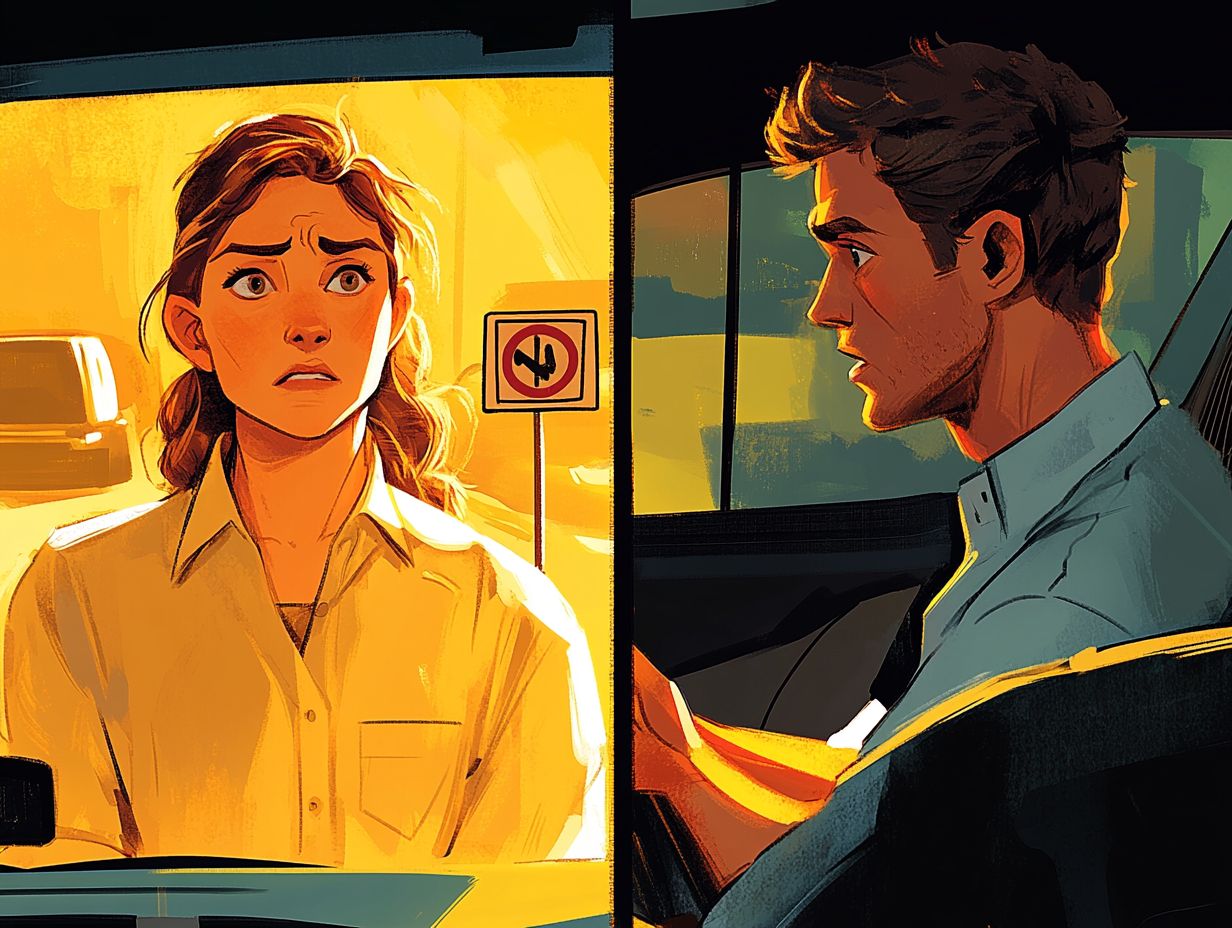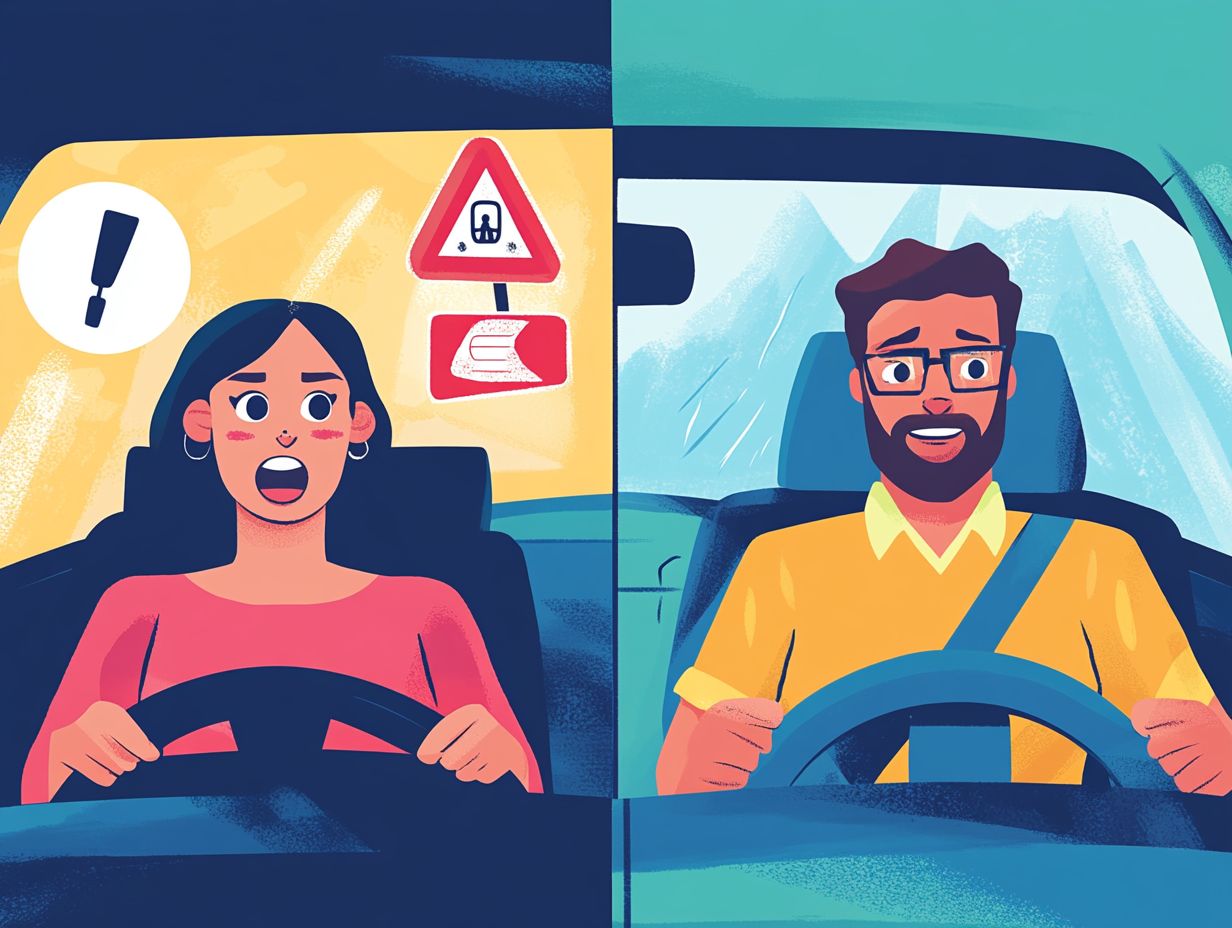5 Myths About High-Risk Driver Insurance Debunked
Are you confused about high-risk driver insurance? Navigating this realm can be quite perplexing, especially with the abundance of misinformation swirling around.
You may encounter several misconceptions that can lead to unnecessary stress and inflated costs. This article aims to debunk five prevalent myths surrounding high-risk driver insurance, clarify what it truly means to be considered a high-risk driver, and explore the factors that influence insurance rates.
Whether you’re looking to lower your premiums or enhance your understanding of your options, this guide will serve as a valuable resource for you.
Contents
- Key Takeaways:
- 1. High-Risk Driver Insurance Is Too Expensive
- 2. High-Risk Drivers Are Automatically Labeled as ‘Bad Drivers’
- 3. High-Risk Driver Insurance Is Only for Young Drivers
- 4. High-Risk Driver Insurance Is Only for Those with DUIs
- 5. High-Risk Driver Insurance Will Negatively Affect Your Credit Score
- What Is Considered a High-Risk Driver?
- What Factors Determine High-Risk Driver Insurance Rates?
- What Are the Different Types of High-Risk Driver Insurance?
- How Can High-Risk Drivers Lower Their Insurance Rates?
- What Are the Consequences of Driving Without High-Risk Driver Insurance?
- What Are the Common Misconceptions About High-Risk Driver Insurance?
- Frequently Asked Questions
- 1. Is it true that high-risk drivers will always have to pay higher insurance rates?
- 2. Are all accidents or violations considered in determining a driver’s risk level?
- 3. Do all high-risk drivers have to get insurance from specialized companies?
- 4. Will my insurance rates stay high forever if I am classified as a high-risk driver?
- 5. Do all high-risk drivers have to pay large down payments for their insurance?
- 6. Is it true that high-risk driver insurance covers less than regular insurance?
Key Takeaways:

- High-risk driver insurance is not always expensive and can actually be affordable if you do your research and shop around for the best rates.
- Being labeled a high-risk driver does not automatically make you a bad driver. It can be due to many factors such as age, driving experience, and past traffic violations.
- High-risk driver insurance is not just for young drivers. Drivers of any age who are considered high-risk can benefit from this type of insurance.
1. High-Risk Driver Insurance Is Too Expensive
High-risk driver insurance often carries the misconception that it’s prohibitively expensive. This misconception leads many drivers to shy away from seeking adequate car insurance coverage, but there are 5 ways to compare insurance for high-risk drivers that can help find more affordable options.
In truth, the cost of insurance can vary widely based on several factors, including your driving history, vehicle identification number, and the specific insurance provider issuing the quote. Grasping these dynamics enables you to navigate the insurance market more effectively.
Previous accidents, speeding tickets, and other traffic violations can inflate your premiums since insurers assess risk based on your past behavior. Your claims history matters a lot; a record filled with claims can signal to insurers a higher likelihood of future claims, inevitably driving up costs.
Don’t settle for high premiums! Taking the time to shop around and compare quotes from different insurance companies can uncover competitive rates tailored to your unique circumstances. Each provider evaluates risk differently, offering the potential for substantial savings for those willing to invest a little effort in research and negotiation.
2. High-Risk Drivers Are Automatically Labeled as ‘Bad Drivers’
The notion that high-risk drivers are simply ‘bad drivers’ is a common insurance myth that fails to capture how insurers look at risk. Many factors influence your risk level, including your history of traffic incidents. Understanding the top 5 factors affecting high-risk driver premiums can often help, especially with programs like accident forgiveness, which assists drivers in avoiding premium increases after an accident.
It’s also crucial to acknowledge that the age of your vehicle significantly shapes your driver profile, often reflecting its reliability and safety features. Newer models, equipped with cutting-edge safety technology, can substantially lower the likelihood of accidents, positively impacting your insurance rates.
Having sufficient liability coverage signals your commitment to responsible driving, enhancing your reputation in the eyes of insurers. By understanding these key elements, you can make well-informed decisions that may lead to more favorable insurance options and potentially lower premiums.
3. High-Risk Driver Insurance Is Only for Young Drivers
It’s a common misconception that high-risk driver insurance is only for younger individuals. In reality, many adults may find themselves classified as high-risk due to various factors in their driving history.
Insurance companies evaluate risk using a range of criteria beyond just age, meaning both young and experienced drivers can face higher premiums. For example, if you have a history of claims especially multiple claims in a short time frame you re more likely to be labeled as high-risk.
Recent traffic violations, such as speeding tickets or DUIs, can significantly raise your risk profile as well. Data from Coverage.com shows that about 28% of drivers under 25 have been involved in car accidents, which certainly contributes to those elevated rates.
Adults aged 30 to 50 may also see their premiums climb if they have similar infractions. This illustrates that high-risk classification can apply to a broad spectrum of ages, not just the young.
4. High-Risk Driver Insurance Is Only for Those with DUIs

DUIs contribute to being labeled a high-risk driver. However, they aren’t the only reason many fall into this category.
Factors such as your claims history, specific insurance requirements, and even vehicle theft can elevate your risk profile, significantly affecting your personal auto insurance rates.
Additional elements like multiple speeding tickets or reckless driving incidents can complicate matters even further. Insurance companies carefully assess your overall behavior on the road, including how often you ve filed claims, even for minor incidents.
Maintaining a clean claims record is crucial. Repeated claims can signal to insurers that you pose a greater risk. As a result, high-risk drivers often face inflated premiums. You ll want to adopt safer driving habits and practice responsible vehicle ownership to effectively mitigate these costs.
5. High-Risk Driver Insurance Will Negatively Affect Your Credit Score
One prevalent myth you may encounter is that having high-risk driver insurance will negatively impact your credit score, adding unnecessary anxiety to an already stressful situation with elevated premiums. The truth is that insurance companies assess risk in various ways. For high-risk drivers looking to mitigate costs, there are 5 ways to improve your insurance status. While your premium rates might rise due to perceived risk, rest assured that your credit score remains untouched by your insurance status.
It s essential to grasp the complex connection between insurance premiums and credit scores. Insurance agents can play a pivotal role in guiding you through how different factors influence your rates. They offer valuable insights on how to maintain financial protection without compromising your credit. Although some insurers might consider credit data in their risk assessments, having high-risk driver insurance will not directly affect your credit history.
Therefore, focus on responsible financial practices. You can take steps today to lower your rates and improve your credit over time, potentially leading to lower insurance premiums in the long run.
What Is Considered a High-Risk Driver?
A high-risk driver is someone whose driving record suggests a greater likelihood of filing a claim, often due to a history of traffic incidents or less-than-stellar driving behavior, as evaluated by insurance companies. You might find yourself classified as high-risk if you have multiple accidents, DUI incidents, or significant traffic violations. These factors lead to increased scrutiny during the risk assessment process.
Beyond these driving behaviors, insurance providers also dive into your claims history. If you’ve filed several claims recently, your risk status could be higher than you think. Frequent claims can indicate a propensity for risky behavior. For instance, if you’ve filed several claims in a short time, you may be viewed as more of a liability than someone with a pristine record.
Geographical location is another crucial factor. Living in an accident-prone area can automatically elevate your risk rating, no matter how well you drive. Urban drivers often face higher premiums due to dense traffic, while those in rural areas might enjoy lower rates.
This illustrates just how unpredictable the classification of risk can be, shaped significantly by individual circumstances.
What Factors Determine High-Risk Driver Insurance Rates?
Several key factors determine insurance rates for high-risk drivers, including your claims history, driving behavior, and the liability limits you select for your auto policy. Insurers analyze these elements to accurately assess your risk and calculate your premium rates accordingly.
If you have multiple speeding tickets, DUI convictions, or a recent accident, you may find yourself categorized as high-risk. This can result in significantly higher premiums. One insurer might place greater emphasis on your reckless driving history, while another may focus more on how often you ve made claims. This variability means you could receive different quotes from various companies, highlighting the importance of shopping around.
Your choice of liability limits also impacts your costs. Opting for minimum coverage may lower your immediate expenses, but it can also leave you more exposed to financial liability in the event of an accident.
What Are the Different Types of High-Risk Driver Insurance?

High-risk driver insurance includes various policies designed to meet the unique needs of drivers with elevated risk levels. These options can range from comprehensive coverage, which protects against damages not related to accidents like theft, to liability coverage and personal injury protection. These tailored packages aim to provide financial security while ensuring compliance with state insurance requirements.
For instance, liability coverage is often legally required and offers protection against claims arising from accidents. However, this coverage might not extend to your own damages, leaving you exposed. Personal injury protection covers medical expenses for you and your passengers, regardless of fault, which is especially beneficial in states where such coverage is mandatory.
Comprehensive coverage shields you from non-collision incidents, which can be particularly advantageous for high-risk drivers. It’s important to remember that the availability and cost of these options can vary widely by state, impacting both the types of policies accessible to you and the overall insurance market landscape tailored for high-risk drivers.
How Can High-Risk Drivers Lower Their Insurance Rates?
High-risk drivers can reduce their insurance rates with several effective strategies. By taking advantage of discounts provided by insurance companies, improving driving habits, and negotiating rates, significant savings can be achieved over time.
A solid starting point is enrolling in defensive driving courses. These courses not only refine your skills behind the wheel but often make you eligible for valuable discounts. Maintaining a clean driving record is essential; insurance providers reward responsible driving behavior.
Shopping around for better insurance quotes can uncover competitive rates that fit your specific needs. Understanding the criteria that insurance companies use to offer discounts is crucial; this knowledge lets you make informed choices and maximize potential savings on your premiums.
What Are the Consequences of Driving Without High-Risk Driver Insurance?
Driving without high-risk driver insurance can result in serious consequences. This includes hefty legal penalties, financial liability if an accident occurs, and an increased likelihood of being labeled as an underinsured motorist. A lack of adequate coverage puts both you and others at significant risk.
For example, many states impose fines ranging from a few hundred to several thousand dollars for being caught without insurance, not to mention the possibility of having your driving privileges suspended. If you’re classified as a high-risk driver, you could face steep surcharges on future premiums, making it even more essential to secure proper coverage.
The financial fallout from property damage or medical expenses resulting from an accident could pose a substantial bankruptcy risk. Therefore, it’s vital for high-risk individuals to prioritize obtaining the right insurance to protect their financial stability and enjoy peace of mind.
Don t wait check your insurance options today and secure the coverage you need!
What Are the Common Misconceptions About High-Risk Driver Insurance?
Numerous misconceptions surround high-risk driver insurance. These myths about auto insurance premiums often leave you confused about your options.
Some may think that high-risk insurance is always prohibitively expensive or only relevant to a specific group of drivers. Addressing these auto insurance myths in Illinois is essential for enabling informed decisions about your coverage.
You might assume that only young or inexperienced drivers face high-risk status. However, anyone with a history of accidents, DUIs, or multiple traffic violations could also fall into this category age is irrelevant.
Many believe that high-risk drivers can’t find affordable insurance options. In reality, various insurance providers cater to these needs, often offering surprisingly competitive rates.
If you find yourself classified as a high-risk driver, consulting with insurance agents can be a game changer! They can clarify these myths and guide you toward 5 tips for managing your high-risk driver insurance that meet your unique circumstances.
Frequently Asked Questions

1. Is it true that high-risk drivers will always have to pay higher insurance rates?
No, this is a common misconception. While high-risk drivers may pay higher rates initially, there are steps they can take to improve their driving record and potentially lower their rates.
2. Are all accidents or violations considered in determining a driver’s risk level?
No, insurance companies consider the severity and frequency of accidents and violations when determining a driver’s risk level. A single minor infraction may not have as big an impact as multiple major accidents.
3. Do all high-risk drivers have to get insurance from specialized companies?
Not necessarily. While some traditional insurance companies may not offer coverage for high-risk drivers, many companies specialize in providing insurance for this group. It’s important to shop around and compare quotes from different companies.
4. Will my insurance rates stay high forever if I am classified as a high-risk driver?
Not necessarily. Many insurance companies reassess a driver’s risk level periodically. If the driver has improved their record over time, they may be eligible for lower rates. It’s vital to continue practicing safe driving habits to potentially lower insurance rates in the future.
5. Do all high-risk drivers have to pay large down payments for their insurance?
No, not all high-risk drivers will have to pay a large down payment for their insurance. This varies depending on the insurance company and a driver’s individual circumstances. It’s important to discuss payment options with the insurance provider.
6. Is it true that high-risk driver insurance covers less than regular insurance?
Not necessarily. While high-risk driver insurance may come with higher rates, it still offers the same coverage options as regular insurance. It’s important to carefully review the coverage offered by different insurance companies to find the best option for your individual needs.
For personalized insurance quotes, don t hesitate to reach out to local providers!




